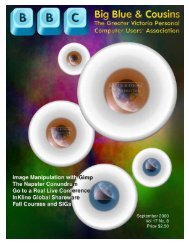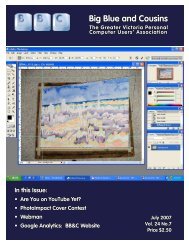Create successful ePaper yourself
Turn your PDF publications into a flip-book with our unique Google optimized e-Paper software.
<strong>Big</strong> <strong>Blue</strong> & <strong>Cousins</strong><br />
(Neither Chronograph nor Nistime made the Tucows list).<br />
Get SymmTime from Tucows.<br />
Tardis <strong>and</strong> K9<br />
Tardis is an advanced <strong>and</strong> mature utility for “synchronizing<br />
time using internet-based Atomic Clocks, networked<br />
timeservers, GPS, radio clocks, <strong>and</strong> by listening<br />
for time broadcasts over a LAN”. I started using Tardis soon<br />
after I installed my first internet dial-up connection. Clocks<br />
on older 286 computers, or mine anyway, were notoriously<br />
unreliable <strong>and</strong> even a periodic dial-up synchronization was<br />
helpful.<br />
From the Tardis History page: “The idea for Tardis came<br />
about way back in 1994 when...<br />
www.bbc.org<br />
Chronograph 4<br />
the company’s Technical Director,<br />
became frustrated with the way his<br />
PC’s clock drifted. ... Having completed<br />
the utility, which he named<br />
“Tardis” after the time machine in<br />
the 1960s cult sci-fi series ‘Dr Who’,<br />
he decided to make it available as<br />
shareware via the Internet.”<br />
(Incidentally, it looks like the<br />
BBC will be resurrecting Dr Who.<br />
For more information on Dr Who<br />
<strong>and</strong> the Tardis time machine see<br />
www.bbc.co.uk/cult/doctorwho/tardiscam/intro.shtml<br />
— much more<br />
interesting than this rather dry<br />
discussion of ways to keep your<br />
computer clock reasonably accurate.)<br />
Tardis can act as both a server<br />
<strong>and</strong> client for the supported protocols.<br />
That is, it can get the time<br />
from a timeserver <strong>and</strong> then make<br />
the time available to local clients.<br />
When running on a central server<br />
(Windows 2000, 2003, XP Pro),<br />
Tardis can act as a master time<br />
source for the domain by running<br />
the appropriate version of Tardis with the smaller K9 on the<br />
other workstations. The K9 program (named after Dr Who’s<br />
Another Opinion<br />
Chronograph 4.0 for Windows<br />
is software that will<br />
accurately set your computer’s<br />
time for you according to one of eleven<br />
NIST time servers in the US.<br />
Why should we worry about our system<br />
clock being accurate in the first place? One good<br />
reason is being able to rely on the time stamps<br />
within your system logs. If your system clock<br />
is out by a few minutes, you might not be able<br />
to tell your ISP when an intrusion happened<br />
or when an email was transferred.<br />
Chronograph 4.0 is very quick <strong>and</strong> easy<br />
to set up. It has a clean, easy to underst<strong>and</strong><br />
interface, <strong>and</strong> with a few extra clicks it can<br />
customized to run automatically. It can also be<br />
set to act as a time server for other computers<br />
on your LAN. You cannot pick your own source<br />
server such as time.nrc.ca, however.<br />
Brad Crockett<br />
<strong>Oct</strong>ober 2004<br />
robot dog) is a small program that runs in the background<br />
<strong>and</strong> will synchronize other LAN computers, including Linux<br />
machines with the main time server. www.kaska.demon.co.uk/<br />
k9.htm. Also see www.ntp.org for Linux NTP time servers.<br />
K9 is not normally needed for home networks.<br />
Tardis can be set to query the time as often as once a<br />
minute — but that seems excessive to me — I find a check<br />
every two hours is sufficient. Tardis<br />
also provides interesting ancil-<br />
lary information like estimated<br />
clock drift.<br />
A pdf file, included with the<br />
program, provides more detailed<br />
information on Tardis <strong>and</strong> shows<br />
how to connect various external<br />
devices to obtain millisecond accuracy.<br />
Tardis is shareware, $20<br />
US. (There is also a version for<br />
Win 3.x.)<br />
Summary<br />
So which is best? Well, Nistime<br />
is free <strong>and</strong> has superior help<br />
screens. SymmTime is also free<br />
<strong>and</strong> can display clocks for several<br />
locations on your desktop.<br />
Chronograph has a fancy display<br />
<strong>and</strong>, like Tardis, can act as a time<br />
server for network computers <strong>and</strong><br />
offers dial-up connections. Tardis<br />
seems to be the most advanced<br />
<strong>and</strong> configurable of the bunch.<br />
However, any would do — as<br />
would most of the programs on<br />
the Tucows website listed above.<br />
As for me, I’ll stick with Tardis if<br />
only for the Dr Who connection. Besides Tardis has served<br />
me well over time.<br />
9





